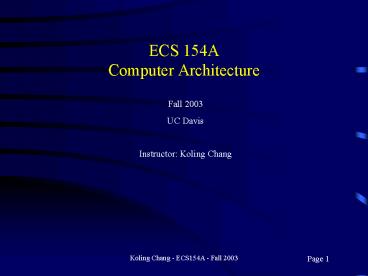ECS 154A Computer Architecture - PowerPoint PPT Presentation
1 / 23
Title:
ECS 154A Computer Architecture
Description:
Boolean Algebra, Gates, Combination and Sequential Logic. ALU. Interconnection. Buses ... Digital Logic Basic: building blocks. 3. Boolean, Logic Design Process , ... – PowerPoint PPT presentation
Number of Views:104
Avg rating:3.0/5.0
Title: ECS 154A Computer Architecture
1
ECS 154AComputer Architecture
Fall 2003 UC Davis Instructor Koling Chang
2
Outline
- Administrative
- Instructor, TA
- Resources
- Grading
- Topic of Study
- Syllabus
- Topic Overview
3
Instructor and TA
- Instructor Koling Chang (kchang_at_cs.ucdavis.e
du) - Office Hour Monday 1105am-1200pm
- Office Kemper Hall, Room 2123
- TA Minh Huynh (huynh_at_cs.ucdavis.edu)
- Course Website http//wwwcsif.cs.ucdavis.edu/cs15
4ab - Prerequisite ECS 50 or EEC 70, and ECS 110
4
Resources
- Textbook S.P. Dandamudi, Fundamentals of
Computer Organization and Design - Lab work software MaxPlus II
5
Grading
- 4 lab-work assignments (6, 6, 10, 10)
(interactive grading) - 3 written homework assignments (18 total)
- Midterm (25)
- Final (25)
- Grading issues have to be raised within a week
- Final grading based on distribution
- A/A- (40)
- B//- (50)
- C/D/E/F (lt10)
6
Topic of Study
- Digital Design
- Boolean Algebra, Gates, Combination and
Sequential Logic - ALU
- Interconnection
- Buses
- Memory
- Memory Systems, Memory Management, Cache, Virtual
Memory - I/O
- Memory mapped/Programmed I/O, DMA, Interrupts,
Networks, Peripherals
7
Syllabus
- 1. Course Overview
- 2. Digital Logic Basic building blocks
- 3. Boolean, Logic Design Process ,
Simplification - 4. Simplification2, Generalized Gates
(hw1) - 5. Combination Circuits mux, demux,
decoder, encoder - 6. Comparators, Fixed-point
Arithmetic, Adder, ALU - 7. Multiplication and Division (lab1)
- 8. Floating-Point Arithmetic, ALU,
- 9. ROM, Programmable Devices
- 10. Sequential Logic clock, latches
(hw2) - 11. flip-flops, counters
- 12. shift register, state machines
- 13. Buses design issues, sync bus, async
bus (lab2) - 14. bus arbitration,
- 15. bus examples (hw3)
- 16. Midterm review
- 17. Midterm
- 18. Memory memory system, memory block
design - 19. larger memory, memory modules, memory
mapping
8
Course Overview
- Various aspects of computer architecture
- Users view (UI)
- Programmers view (OS/API/ISA)
- Implementers view (Arch./Funct. spec, low-level)
- Architects view (PRD, high-level)
9
A Users View
10
A Programmers View
11
Architects View of a System
12
Implementers View
- Observing design specification from architecture
team - Designing and implementing detail components to
meet requirements
13
CPU
14
CPU Example
15
ALU Example
16
Memory
- Ordered sequence of bytes
- The sequence number is called the memory address
- Byte addressable memory
- Each byte has a unique address
- Memory address space
- Determined by the address bus width
- Memory size is limited by address space
- Pentium has a 32-bit address bus
- address space 4GB (232)
17
Memory Unit
- Address
- Data
- Control signals
- Read
- Write
18
Memory Mapping
19
Buses
- System components are interconnected by buses
- Bus a bunch of parallel wires
- Uses several buses at various levels
- On-chip buses
- Buses to interconnect ALU and registers
- A, B, and C buses in our example
- Data and address buses to connect on-chip caches
- Internal buses
- PCI, AGP, PCMCIA
- External buses
- Serial, parallel, USB, IEEE 1394 (FireWire)
20
System and Bus Example
21
I/O
- I/O devices are interfaced via an I/O controller
- Takes care of low-level operations details
- Several ways of mapping I/O
- Memory-mapped I/O
- Reading and writing similar to memory read/write
- Uses same memory read and write signals
- Most processors use this I/O mapping
- Isolated I/O
- Separate I/O address space
- Separate I/O read and write signals are needed
- Pentium supports isolated I/O
- Also supports memory-mapped I/O
22
I/O
Interrupts
23
How Do We Build Them?
- Everything is logic.
- Logic is represented by voltages and operated by
logic gates. - Complex system is built from functional units,
components, and devices. - Lets continue with logic design next week.





























